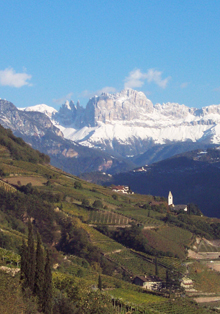Subtotal: $
Checkout
A Fugitive Church
Joining This Movement Could Cost You Your Life
By Emmy Barth Maendel
October 30, 2012
Society seems to be crumbling. Year after year taxes are increased; the rich get richer and the poor poorer. There is intrigue in politics and corruption among the clergy.
The year is 1530. The bishop, Georg III of Austria, is a 21-year-old, out-of-wedlock son of Emperor Maximillian I, who got his diocese through a special dispensation arranged for him by his half-brother King Ferdinand of Austria.
A few years ago there was an uprising of the peasants. No longer able to contain their anger, they erupted, burning and plundering the homes of the rich.
Valtin Luckner is a young shoemaker in a village in South Tirol (the mountainous region that will later become northern Italy). He has just acquired a German New Testament—which has only recently appeared for sale in town market squares. He has been reading it eagerly and one day falls into conversation with his apprentice Matthew. Matthew is familiar with the Bible, too. “Are you living according to what you read?” Mathew asks him. “That is the real question. Do you believe?”
“Yes, I believe,” Valtin answers, surprised.
“More is required,” Matthew insists. “You should live according to God’s will and be baptized on your faith. Baptizing babies was commanded by the pope, but God commanded a different baptism, based on faith.”
“Who would baptize me?” Valtin asks.
Matthew tells him about the new movement that has been sweeping through Europe. A group in Zurich was studying Scripture and decided to baptize one another as a sign of committing their lives to God alone. But it is against the law. Remembering the recent Peasants Revolt, both church and secular authorities are frightened of what could happen if the common people take things into their own hands, so they have made “Anabaptism” or “re-baptism” a capital offense.
This gives Valtin a lot to think about, and he has no peace. He learns of others who are part of this movement and at every opportunity he asks eagerly about their beliefs and practices.
One day two of them come to his home, asking for food and drink. One of them introduces himself as Jacob Hutter. He is perhaps in his mid-twenties, an energetic and forthright man with black hair and beard. He asks Valtin if he would like to know the divine truth. “Yes,” Valtin answers, “If only there were someone who could teach me.” They talk for a long time. Hutter tells him that baptism means dying to his old life and beginning life anew in Christ.
They go outside. Valtin kneels down and prays God to forgive his sins. “Do you believe in God, in Jesus Christ, and in the Holy Spirit?” Hutter asks him.
“Yes,” Valtin answers.
“God has forgiven your sins. Now you must renounce your flesh and blood.” Hutter takes a pitcher of water and baptizes him “in the name of the Father, the Son, and the Holy Spirit.”
Valtin becomes an eager missionary for the movement. Whenever he senses that someone is discontented he offers him the comfort he has found. The people are like sheep without a shepherd; for them church rites have become superstitions, and the priests seem to care more for their own bellies than for the lost souls. People respond to the care they feel from Valtin, who takes time to listen to their distress.
But those who give ear to the new message do so at their peril. Mandates are issued: Anyone who harbors an “Anabaptist” will be fined. Houses they have met in will be burned. Anyone who has been baptized will be executed—men beheaded, women drowned, and those who have baptized others burned to ashes at the stake (to ensure that their bodies cannot be buried and to deny them the resurrection). They can be pardoned by making a public recantation in church and taking communion, but they must swear never to join the re-baptizers again.
In spite of such penalties, the movement continues to spread. Valtin becomes one of the organizers of the network of believers. He goes from house to house, announcing meetings and encouraging his new “brothers and sisters.” It is not safe for him to live at home any longer, so he often camps out in the woods on the lower mountain slopes. There are huts in the upper pastures that are free for villagers to use. When it rains he sleeps in one of these; often he finds bread and bacon fat left by another fugitive or a sympathizer.
Conferences are joyful festivals. Sometimes up to a hundred brothers and sisters meet deep in the forest and spend several days together. At such occasions there might be a baptism, or someone who has recanted or sinned in some other way is reaccepted. Often they celebrate the Lord’s Supper. Brother Hans Mair Paulle organizes the food for the crowds. One or two oxen are driven to the place of the meeting, where they are slaughtered and roasted. Loaves of bread are bought from the local baker and brought up. In order to protect their supporters, Valtin is never told who has provided the food.
Valtin Luckner’s death is not recorded. But on October 6, 1533 he is tried under torture. His activities, the names of brothers, sisters, and accomplices are forced out of him, but he never wavers from the truth he has found:
I will not turn away from this faith, may God’s grace protect me. With the help and strength of God I will endure, suffer death, and witness with my blood that this is the divine truth. May God help me. Even if they make me sin by forcing more out of me, I will not recant.
It can be assumed that Valtin Luckner was executed, probably burned to death because he was recognized as a leader. Thousands of Anabaptists are executed, but the movement never dies. Five hundred years later, there are people practicing this same radical dedication to their faith on every continent. Anabaptist groups today include the Mennonites, Amish, Hutterites, and Brethren.
Material for this account is taken from Mecenseffy, Grete, ed: Quellen zur Geschichte der Täufer XIV. Band: Österreich III. Teil, Gütersloher Verlagshaus Gerd Mohn 1983.

Already a subscriber? Sign in
Try 3 months of unlimited access. Start your FREE TRIAL today. Cancel anytime.






